 8 Aug 09
8 Aug 09 6 Nov 09
6 Nov 09[ Home ] [ Up ] [ Previous Page ] [ Next Page ]
Model Rectifier Corporation (MRC) has been making basic DCC systems for quite a while. They also make some basic DCC decoders. The primary advantage of these decoders is that they are inexpensive in comparison to other decoders with similar functions. The disadvantage of these decoders is that they are very basic, generally lagging the designs of most other decoder manufacturers by 10 years or more.
I have used two versions of their decoders, the AD320 and AD322. These are both versions intended for large scale trains and hence have competent motor drivers. I got the AD320 as an experiment because it was half the price of other decoders rated at similar current. I got the AD322 decoders (5 of them) because MRC was blowing them out at $11 each. They have a motor driver rated at high current (8 amps) and also have some form of diesel sound.
My overall recommendation for both of these items is to maintain low expectations relating to the performance and reliability of these decoders. They do work, but not particularly well.
Virtually all of information that is on this page can be found in other places on this site, but I am using this page to collect that widely spread information in one place.
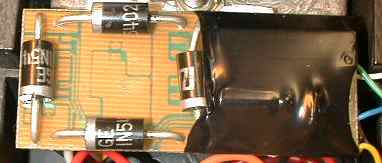 The AD320 is a 2.5 amp average
current decoder with 4 functions. It is a slightly beefier version of
the AD310 which is smaller, has a smaller motor driver and only two
functions.
The AD320 is a 2.5 amp average
current decoder with 4 functions. It is a slightly beefier version of
the AD310 which is smaller, has a smaller motor driver and only two
functions.
There are no special attributes that can be applied to the AD320 functions except that the ones assigned to the headlight (F0f and F0r) automatically reverse. F1 and F2 are simply on or off. The motor driver uses a low PWM frequency so that, depending on the motor that it is used with, it can make a lot of noise.
This one decoder has been in and out of several locomotives simply because it worked so poorly. For some reason, the motor noise that was so severe in other locos was not a problem in the Aristo Railbus. There is perceptible motor noise, but it is not very loud and is generally drowned out by the sound system in the Railbus.
This is where this one decoder has been used, more or less in the order of installation.
| Locomotive | Link | Notes |
|---|---|---|
| Aristo 0-4-0 | Aristo 0-4-0 Tips | The thing made so much noise that it got ripped out of there really fast. |
| Lionel Handcar | Lionel Handcar Tips | It made a lot of noise in the handcar and it ran too fast. |
| Aristo Classic Railbus | Aristo Classic Railbus Tips | It actually works well in the Railbus. I pulled it because I needed a decoder with more functions so it got replaced with a Digitrax DG583S. |
| Lionel James | Thomas and James Tips | It ran in James for awhile, then one day it died in a puff of smoke. I'll no longer be bothered by this POS decoder. |
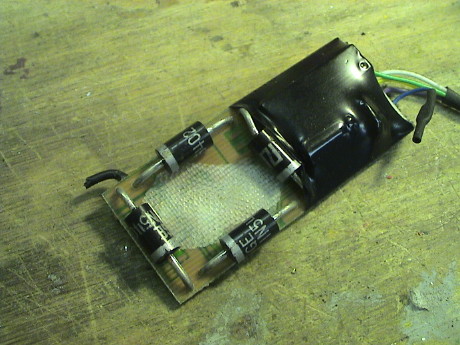 A couple of months back,
I was doing some testing on another loco and put some DC on the track.
James was sitting on the track and while it didn't make a sound from
across the room, it burnt up and I could smell it. I didn't know what
burnt at the time, but later I suspected that it was James as the smell
was strongest from that part of the room and everything else there
worked.
A couple of months back,
I was doing some testing on another loco and put some DC on the track.
James was sitting on the track and while it didn't make a sound from
across the room, it burnt up and I could smell it. I didn't know what
burnt at the time, but later I suspected that it was James as the smell
was strongest from that part of the room and everything else there
worked.
After some extended travel to Ecuador, I finally made it back to the GIRR Mtn Div and took James apart. It was pretty obvious that the AD320 had seen better days. The circuit board on the rectifier side had delaminated and warped.
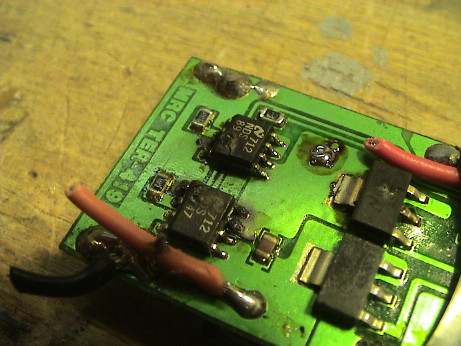 On the other side,
below the warped part of the board, several devices were clearly burnt
up with cracked and charred epoxy packages. This thing had seen some
serious heat. It got replaced with a Digitrax DG583S and I expect that
I'll have no more problems with James. It runs much better too.
On the other side,
below the warped part of the board, several devices were clearly burnt
up with cracked and charred epoxy packages. This thing had seen some
serious heat. It got replaced with a Digitrax DG583S and I expect that
I'll have no more problems with James. It runs much better too.
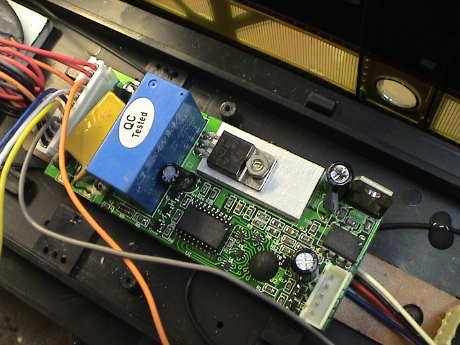 The AD322 is
an "8 amp" decoder with integrated diesel sounds. MRC originally sold
these for about $80 MSRP but they were, and maybe still are, being sold
on the MRC web site for $10.99. They know what the decoders are really
worth.
The AD322 is
an "8 amp" decoder with integrated diesel sounds. MRC originally sold
these for about $80 MSRP but they were, and maybe still are, being sold
on the MRC web site for $10.99. They know what the decoders are really
worth.
The decoder has the normal two reversing functions and four additional functions that can be modified with a single set of attributes for ditch lights and strobes.
The sound is marginal at best. It makes a diesel "idle" sound and a "run" sound with a sort of a transition between them. There is a fair bell and horn. A sample of the sounds can be found in this video. F2 plays a long horn sound that will play as long as F2 is active. F3 plays a short horn when F3 transitions between on and off. By using F2 and F3, reasonable horn signals can be sounded. The sound can, fortunately, be muted. The bell and horn will play when muted, but they will also enable the engine sound for as long as the bell or horn is playing.
The motor controller pulses at about 250 Hz. The resulting motor noise can be easily heard in some installations. This also can be heard in the last part of the video.
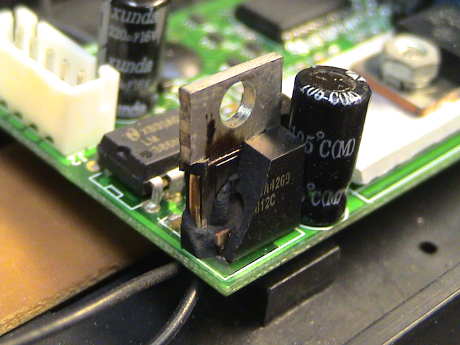 One of mine blew up. It was in a consisted FB and it
couldn't figure out what direction to run. At one point, the locos were
fighting each other and the FB lost. The decoder simply blew up. At the
time, these locos were set at the default of CV29=06. This enables
analog conversion. I put another AD322 in and the two locos consisted
together misbehaved. After setting CV29=02 to disable analog conversion
in both locos, the two ran reasonably well together and both decoders
seem to be surviving.
One of mine blew up. It was in a consisted FB and it
couldn't figure out what direction to run. At one point, the locos were
fighting each other and the FB lost. The decoder simply blew up. At the
time, these locos were set at the default of CV29=06. This enables
analog conversion. I put another AD322 in and the two locos consisted
together misbehaved. After setting CV29=02 to disable analog conversion
in both locos, the two ran reasonably well together and both decoders
seem to be surviving.
This issue with a consisted loco has also happened to at least one other user. It seems that there might be a problem with these decoders used in consisted locos, especially if analog conversion is enabled.
I believe that a major weakness of the AD322's design is the reversing relay. There must be enough track voltage to pull in the relay to get it switch directions. In my installations, the relay seems to want to pull in to go forward. If the track voltage is intermittent while running forward, the relay can chatter, in effect altering the direction of the loco rapidly. When the track power comes back on, it takes a short time for the relay to pull in again. During that time the decoder can be trying to drive the motor backwards. This is hard on the motors and gearing. It can also be hard on the decoders if two consisted locos are bucking each other. This may be why this one blew up.
The relay also materially messes up analog conversion. It takes quite a bit of track voltage to get the relay to pull in and the decoder seems to start driving power to the motor before the relay pulls in. This can cause the loco to run "backwards" until the relay finally does pull in, and then the loco reverses hard. Since these decoders analog convert so poorly, it would be reasonable to set CV29=02 to turn analog conversion off.
| Locomotive | Link | Notes |
|---|---|---|
| Aristo FA1 | Aristo FA-1 Tips | The thing ran but the sound is awful |
| Aristo FB1 | Aristo FA1 Tips | The first decoder blew up as a consisted loco, the 2nd decoder seems to be working after a fashion. |
| Bachmann Big Hauler | Bachmann Big Hauler Tips | It works ok in the Big Hauler and except for the motor noise, it works. The diesel sound is not connected. |
| Aristo FA1 | Aristo FA-1 Tips | This one had been converted to battery power but I added a DCC decoder to it too to allow it to run under DCC consisted with the other two for an A-B-A lashup. It now gets more run time than it did when it ran on battery power. It will still run with battery RC when needed that way. Eventually, the terrible sound that the AD322 made caused me to remove it and replace it with a DG583S and a Dallee #696. The sound now plays on battery power too. |
[ Home ] [ Up ] [ Previous Page ] [ Next Page ]
This page has been accessed times since 28 Nov 08.
© 2008-2009 George Schreyer
Created 28 Nov 08
Last Updated November 6, 2009